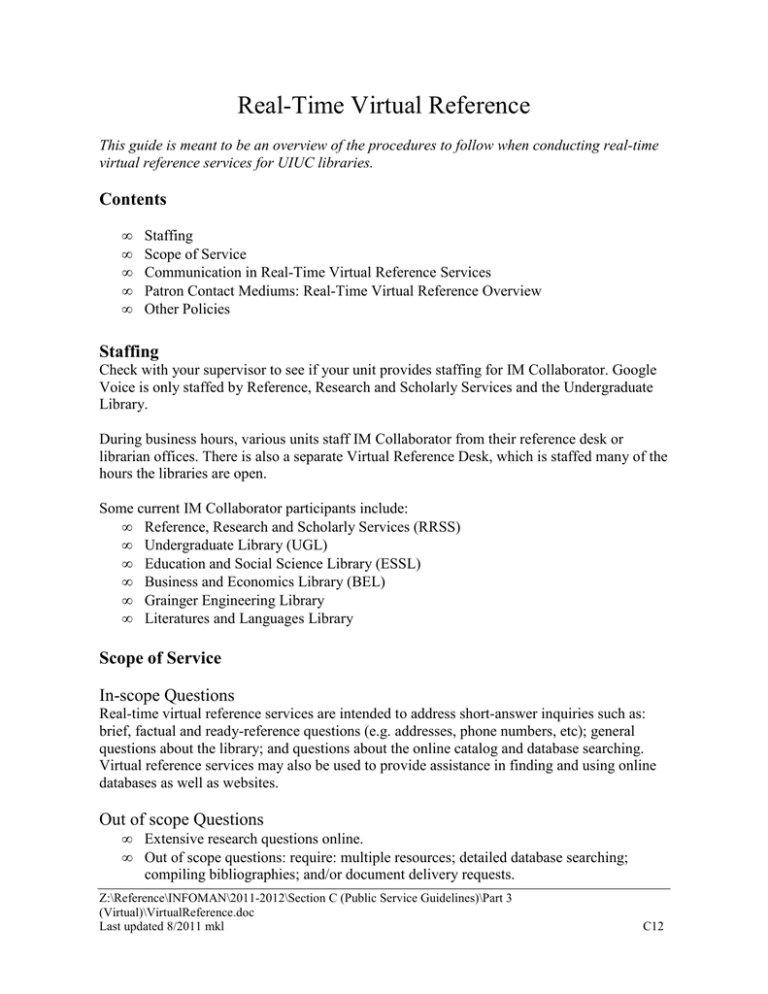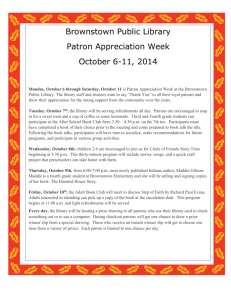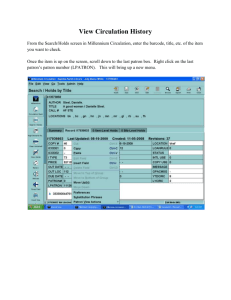Real-Time Virtual Reference
advertisement

Real-Time Virtual Reference This guide is meant to be an overview of the procedures to follow when conducting real-time virtual reference services for UIUC libraries. Contents • • • • • Staffing Scope of Service Communication in Real-Time Virtual Reference Services Patron Contact Mediums: Real-Time Virtual Reference Overview Other Policies Staffing Check with your supervisor to see if your unit provides staffing for IM Collaborator. Google Voice is only staffed by Reference, Research and Scholarly Services and the Undergraduate Library. During business hours, various units staff IM Collaborator from their reference desk or librarian offices. There is also a separate Virtual Reference Desk, which is staffed many of the hours the libraries are open. Some current IM Collaborator participants include: • Reference, Research and Scholarly Services (RRSS) • Undergraduate Library (UGL) • Education and Social Science Library (ESSL) • Business and Economics Library (BEL) • Grainger Engineering Library • Literatures and Languages Library Scope of Service In-scope Questions Real-time virtual reference services are intended to address short-answer inquiries such as: brief, factual and ready-reference questions (e.g. addresses, phone numbers, etc); general questions about the library; and questions about the online catalog and database searching. Virtual reference services may also be used to provide assistance in finding and using online databases as well as websites. Out of scope Questions • • Extensive research questions online. Out of scope questions: require: multiple resources; detailed database searching; compiling bibliographies; and/or document delivery requests. Z:\Reference\INFOMAN\2011-2012\Section C (Public Service Guidelines)\Part 3 (Virtual)\VirtualReference.doc Last updated 8/2011 mkl C12 Most out of scope questions should be answered by providing instruction on how to find and use a few resources to get the patron started (e.g. showing the patron how to use the OPAC or Academic Search Premier). The patron should then been asked to come into an appropriate library for in-depth assistance. When referring provide: • Appropriate contact information • Directions and hours of the suggested library to visit Users Virtual Reference is intended for UIUC students, faculty, staff, and related affiliates. We cannot perform general research for non-affiliated patrons. There are two important exceptions to this rule: Assistance can be provided to non-affiliated patrons only if the question can be answered quickly or if the question relates to specific UIUC Library collections, history, or services. Examples of questions we will answer from public patrons: • Do you have xyz article in the Sandburg collection? • Who was president of the U of I in 1968? Examples of questions/scenarios we won’t answer from public patrons: • I need to find articles for research on plant cell biology. • How many people were on welfare in Georgia from 1963 to 1967? • Requests to perform database searches or requests for online articles: o These questions fall outside the scope of service to non-affiliated users and licensing restrictions prevent sending information from our databases. These resources may be used by non-affiliated patrons onsite, but we cannot serve as intermediaries by sending citations and articles to non-affiliates. • Requests for Interlibrary Loan (ILL) o Non-affiliated users frequently want to know if UIUC owns a particular title they can borrow though ILL. Search the online catalog to verify whether we own an item, but the non-affiliated patron must contact their local library if they want to borrow the material through ILL. Searching WorldCat to determine which libraries have the item falls outside the scope of service to non-affiliated users. Any question that is out of scope should be referred to the non-affiliated patron’s local public/academic library, or to the Internet Public Library at http://www.ipl.org. NOTE: It may be in your best interest to ask the affiliation of a patron early in the virtual reference interaction in order to better assist with their needs. Time Limit Interactions through virtual reference services should generally be limited to about 15 or 20 minutes. The time limit can be flexible as other demands allow. Z:\Reference\INFOMAN\2011-2012\Section C (Public Service Guidelines)\Part 3 (Virtual)\VirtualReference.doc Last updated 8/2011 mkl C13 Communication in Real-Time Virtual Reference Services Virtual reference service lends itself to an informal communication style, however, it is paramount to maintain a professional demeanor. The reference interview should always be used, and it is a good idea to always try to cite the sources consulted to answer questions. Good reference interviewing techniques: • • • Asking open and closed questions to determine the patron’s exact information need before beginning to search. Providing instruction in how to use library resources, including showing patrons where databases are located, and explaining how to perform searches in them Verifying that the patron understands their search results, and that it is what they are looking for. Our mission is the same in the online environment as in person: we want to answer patrons’ questions. Another part of our mission is to provide some level of instruction to those who are interested. Ideally, the interaction will involve you and the patron as you share equally the experience of the search. Important Chat Guidelines • • • • • Maintain continuous communication (try to not let more than two minutes go by between chatting or they may think they’ve been disconnected) All the ordinary visual cues are absent in your exchange Communicate reasons for delay (i.e. if you are spending some time looking for an answer, or another patron walks up to the desk) Ask questions to assess patrons’ level of skill If they seem like capable searchers, you could have them search in one article database while you look in another. If they don’t know how to search in that database, get them started so you can check other good sources. Patron Contact Mediums: Real-Time Virtual Reference Overview Patrons can contact the library for real-time reference assistance in a few different ways. Here are the basics, including information about the division of chat traffic. 1. Ask a Librarian Wimzi Widget You can find the library’s Wimzi Widget on the Ask a Librarian web page at http://www.library.illinois.edu/askus/. One very important thing to know about the Wimzi Widget: If a patron navigates away from this site in the middle of a chat, you will lose contact with the patron. Z:\Reference\INFOMAN\2011-2012\Section C (Public Service Guidelines)\Part 3 (Virtual)\VirtualReference.doc Last updated 8/2011 mkl C14 Questions entered through the Wimzi Widget funnel into the IM Collaborator queue. The IM Collaborator software allows multiple operators to monitor a single AIM account (called: askillinois) and share the incoming IMs. See IM Collaborator instructions. 2. Personal Chat Service (AOL, Yahoo, MSN, or Google) Patrons can also contact us by adding the library’s screen name to their chat service contact list. Libraries participating in chat services list their screen names on their web sites. 3. Text Messaging (SMS) Patrons can also contact us using the library’s text messaging service. The number is (217) 686-4361 and the service is monitored during the same hours as other Ask a Librarian services. SMS service is monitored through Google Voice; RRGIS and Undergrad share responsibility for answering queries. This service is not recommended for in-depth assistance, but is more appropriate for ready reference questions. Patrons needing in-depth research assistance who contact us by text should be referred to use another means of contact. (Note for patrons: Standard charges apply, based on their cell phone plan, for both messages they send and receive from the library.) Other Policies and Procedures Times For Virtual Reference Services The times IM/chat services are available vary depending on the practices of the staffing libraries. Check with your supervisor to see if and when you will staff IM/chat. Referrals and Follow-up: Whenever possible, users should be instructed to perform transactions like renewals and requests online. If this is not possible, they can be directed to the appropriate library e-mail address and/or phone number. If a question becomes lengthy or complex (e.g., a difficult bibliographic verification), offer to get back to the user by phone or e-mail. IM Collaborator does allow for the transfer of an IM from one operator to another. When transferring a chat, always consult with the librarian you will be transferring the chat to first. You’ll also want to let the patron know that you will be transferring them to another librarian. Z:\Reference\INFOMAN\2011-2012\Section C (Public Service Guidelines)\Part 3 (Virtual)\VirtualReference.doc Last updated 8/2011 mkl C15 Confidentiality Users should never be asked for their Net-ID or password, library ID, Social Security number, etc. Patrons are entitled to the same confidentiality regarding their individual questions as they have for in-person requests, so if you are conferring about a patron’s question, do not use their name or anything that links a particular patron to a particular question. Never disseminate a patron’s question other than to make a referral to another library unit. The text of virtual reference sessions will be monitored for training and evaluation purposes, as well as statistics. This log will be reviewed on a regular basis. Clarifications, corrections, and additional suggestions will be sent to the group as a whole. Priority of Service When staffing IM/chat from a public service point, users take priority in the order contact was made. We have found that most people will accept an IM as a ‘person’ ahead of them in the queue and will wait. Normally, users should not be asked to wait longer than five minutes. For example, if you are on an IM and there is someone else waiting (on IM, chat, or in person), get the first patron started. Explain that there is someone else waiting, but that you will come back to him or her. It is often possible to assist an in-person patron who has a short question at the same time as you have a chat patron on the line (or vice-versa). This does require some juggling and you will become more adept with it over time. Use your professional judgment about what you can handle. Z:\Reference\INFOMAN\2011-2012\Section C (Public Service Guidelines)\Part 3 (Virtual)\VirtualReference.doc Last updated 8/2011 mkl C16



